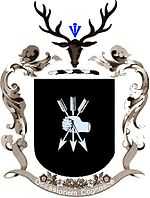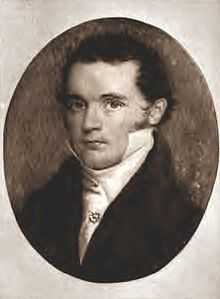Lowell family
| Lowell | |
|---|---|
 | |
| Current region | United States |
| Connected families | Lawrence |
The Lowell family settled on the North Shore at Cape Ann after they arrived in Boston on June 23, 1639. The patriarch, Percival Lowle (1571–1664), described as a "solid citizen of Bristol",[citation needed] determined at the age of 68 that the future was in the New World.
Massachusetts Bay Colony Governor John Winthrop needed solid, dependable people to settle the North Shore area as a buffer against the French from Canada and he urged that the Lowells relocate to Newburyport on the Merrimack River, at the border of the failing Province of Maine.
Ancestry in England
Origin of the name
Many suggestions about the origins of the medieval name Lowle were offered during the late 20th century. Some argued that it was Welsh or Saxon while others supported the name was of Norman origin. One possibility is that it originates from the Latin word lupellus (wolf-cub) from Latin lupus (wolf).
Lowell family historian Delmar R. Lowell, gave much weight and persuasion to the origins of the name Lowle in his work and he and others concluded the Lowles of England were unquestionably of Norman descent.[1]
There were still Louels in Scotland on the Scottish Marches in the Royal Burgh of Roxburgh when Edward Longshanks, King of England, ordered the nobility and gentry in Scotland to swear an oath of allegiance to him in the Ragman Roll in 1291. It is during this period, in 1288, that the earliest documentation for the name Lowle appears. William Lowle of Yardley in Worcestershire is documented as a yeoman, and standing as a witness to a border dispute between two of his neighbours. It is from this period that Delmar Lowell traces the descent of the Lowles through England until their departure for the colonies.
Documentation for this period also exists in The National Archives of England showing that there were also Lowels in the Welsh Marches. In 1317, William de Braose, 2nd Baron Braose petitioned King Edward II, the King's Council, and the Parliament to request that Roger Mortimer, 1st Earl of March send two justices to arrest and bring to trial 200–300 men he accused of attacking his Knights and Ministers and for, "trespasses made against the King's peace to Brewose and his people of Gower.", a peninsula, part of Glamorgan in Wales. Members named in this band of men included Ieuan and Griffith Lowel for the attack at Eynon.
Coat of Arms
The Harleian Society, a British publisher of the official Royal Heraldic visitations, describes the Lowle Coate of Arms from the herald's records taken in Somersetshire in the years 1573, 1591, and 1623.
- Blazon: Sable, a dexter hand couped at the wrist grasping three darts, one in pale and two in saltire, all in argent.
- Crest: A Stag's head cabossed, between the attires a pheon azure.
- Motto: Occasionem Cognosce (oh-kay-see-OH-nem kogg-NOHS-keh).
The English translation: A shield with black field displaying a right hand cut-off at the wrist and grabbing three arrows, one vertical and two crossed diagonally, in silver. Above the shield, a male deer's head mounted behind the ear, and between its antlers a barbed, broad arrowhead in blue. And a loose translation of the family motto, Know Your Opportunity.
The use of the Lowle Coate of Arms has varied slightly between the generations; some families omitted the pheon azzure or substituted blunted bolts for the pointed darts; and one generation, notably a pastor, used an urn in his families crest instead of the stag's head. The right for a man to bear arms traditionally passes from father to eldest son; occasionally subsequent generations change the Coat of Arms to reflect their lives or vocations better, sometimes even "quartering" their Coat of Arms with another family by way of marriage.
It's mentionable that some believe that the Lowle Coat of Arms fell into abeyance when Percival Lowle and his sons emigrated to Massachusetts. They were still subjects of the Crown and its favor until the colonies declared Independence from Britain in 1776 and were entitled to bear their Coat of Arms. Also, there were a number of Lowles who remained in England who could claim the right.
Lowle to Lowell
After Percival Lowle emigrated to the New World with his sons and after some subsequent generations Lowle became Lowell. Delmar Lowell suggests that Rev. John Lowell was the catalyst in getting the Lowell family into cohesion regarding the spelling of the surname sometime after 1721. At the time, Lowells all over New England spelled their names as many different ways as there were branches. Some spelled their surname Lowel, Lowle, Lowell, Lowl, and some spelled it Louell, and Louel even after arriving in the new world. Spelling was so poorly controlled that some early wills show one son with the name Lowle while another son is Lowel and the wife as Lowell all in the same document. It's unlikely that one member of the family had such a big impact on the name. He may well have influenced many Lowells in America to be consistent, however, documentation shows that Lowles in England started spelling their name Lowell around this time as well. By the mid 18th century in England there are plenty of documents for Lowells and none for the prior spellings. This suggests that the proliferation of literacy and a trend to standardize the English language caused members of the family on both sides of the Atlantic to adopt the phonetic spelling.
Notable Lowells
- Abbott Lawrence Lowell, lawyer, historian, philanthropist, and former President of Harvard University
- Amy Lowell, poet, critic, publisher, and sister of Abbott Lawrence and Percival Lowell
- Augustus Lowell, businessman, philanthropist, and father of Percival, Abbott Lawrence, and Amy Lowell
- Carey Lowell, actress and wife of actor Richard Gere
- Charles Russell Lowell, Sr., Unitarian pastor, son of The Old Judge, father of James Russell, and great-great grandfather of Robert Lowell
- Charles Russell Lowell, Union General and Civil War hero
- Delmar R. Lowell, pastor, Civil War veteran, and genealogist
- Edward Jackson Lowell, author and father of Guy Lowell
- Francis Cabot Lowell (1775–1817), businessman and namesake of Lowell, Massachusetts
- Francis Cabot Lowell (1855–1911), U.S. Congressman and Federal Judge
- Guy Lowell, architect and landscape designer
- Hilena Lowell, industrialist, shoe manufacturing, 1880's at Uxbridge, Massachusetts
- James Russell Lowell, poet, critic, publisher, abolitionist, Harvard professor, and foreign diplomat
- Joan Lowell, actress and newspaper reporter
- Rev. John Lowell, colonial era Massachusetts minister
- John Lowell aka The Old Judge, Federal Judge appointed by President George Washington and American Revolutionary
- John Lowell, Jr., aka The Boston Rebel, Federalist lawyer and son of The Old Judge
- John Lowell, Jr. Son of Industrialist Francis Cabot Lowell and founder of the Lowell Institute
- John Amory Lowell, businessman and philanthropist
- Judge John Lowell, Federal judge and son of John Amory Lowell
- Josephine Shaw Lowell, sister of Civil War hero Robert Gould Shaw, first woman to hold a public office in New York City, and wife of Gen. Charles Russell Lowell
- Maria White Lowell, poet, abolitionist, and wife of James Russell Lowell
- Percival Lowell, author, astronomer, founder of Lowell Observatory, and brother of Amy and Abbott Lawrence Lowell
- Ralph Lowell, businessman, philanthorpist, and founding force behind Boston's WGBH public television
- Robert Lowell, poet and lecturer
Among those, Abbott Lawrence, Amy, Augustus, Carey, Charles Russell Sr., Charles Russell, Edward Jackson, Francis Cabot, Guy, John Amory, Judge John, Percival, and Robert are known to be descendants of Percival Lowle.
Other notable descendants:
- Sir Cuthbert Ackroyd, 1st Baronet, Lord Mayor of London (1955–56)
- Godfrey Lowell Cabot, businessman and philanthropist
- Julian Lowell Coolidge, mathematician
- Abbott Lowell Cummings, noted Yale architectural historian
- John Lowell Gardner II, art collector
- William Lowell Putnam, banker, lawyer, and philanthropist
- William Lowell Putnam III alpinist, broadcasting executive
- Ava Lowle Willing, Philadelphia socialite and ex-wife of John Jacob Astor IV (RMS Titanic casualty)
Other descendants of Percival Lowle: [citation needed]
- McGeorge Bundy, former National Security Advisor to Presidents John F. Kennedy and Lyndon Johnson
- Dick Cheney, Ex-Vice President of the United States
- Herman Melville, author
- John Lothrop Motley, historian
- Tuesday Weld, actress
- Tennessee Williams, playwright
- William Whipple, signer of the United States Declaration of Independence
- T. S. Eliot, poet
- Edward Arlington Robinson, poet
- Elliot Richardson, United States Attorney General
Portrait gallery
-

A. Lawrence Lowell
See also
- First Families of Boston
- Lowell Institute
- Lowell, Massachusetts
- Lowell disambiguation page
References
- ↑ Lowell, Delmar R., The Historic Genealogy of the Lowells of America from 1639 to 1899 (pp 208-209); Rutland VT, The Tuttle Company, 1899; ISBN 978-0-7884-1567-8.
External links
- The Historic Genealogy of the Lowells of America from 1639 to 1899 is available for free download at Google Books.
- Domesday Books The National Archives, England
- The Ragman Roll
-
 "Lowell, John". Appletons' Cyclopædia of American Biography. 1900
"Lowell, John". Appletons' Cyclopædia of American Biography. 1900 -
 "Lowell, the name of a distinguished family of Massachusetts". The American Cyclopædia. 1879.
"Lowell, the name of a distinguished family of Massachusetts". The American Cyclopædia. 1879.




